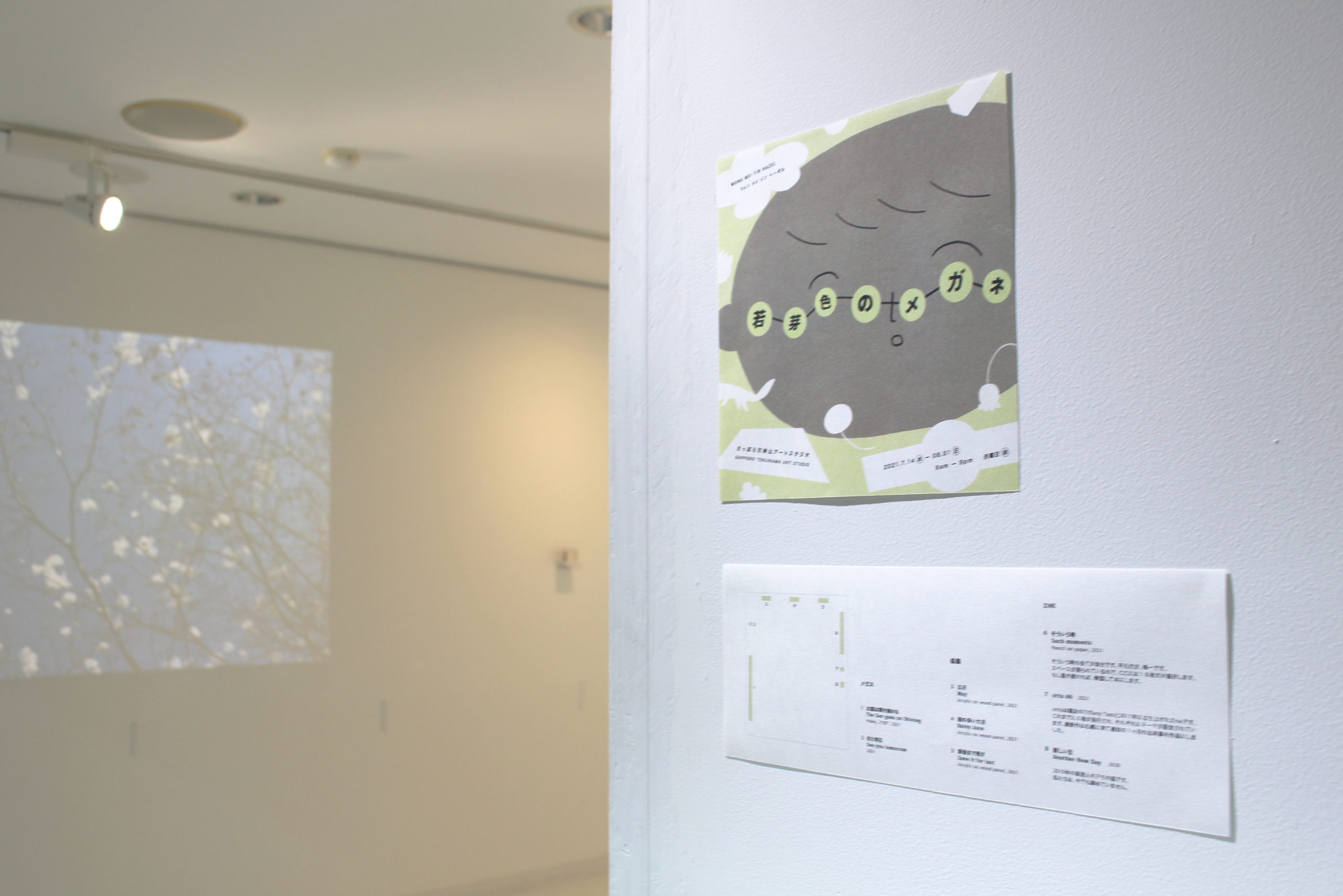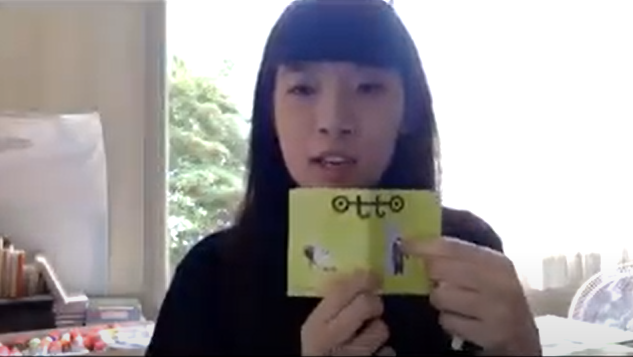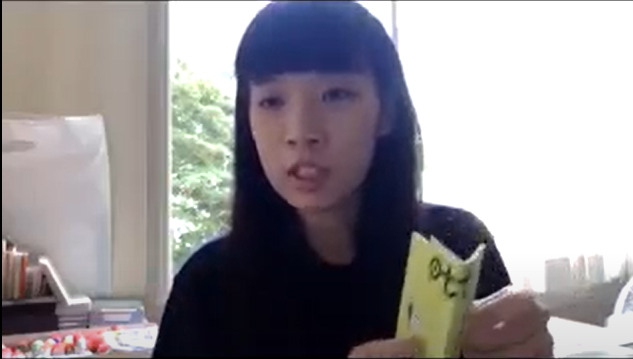
Hello! Here is another interview special from the Tenjinyama office. In this article, we feature an artist / zine publisher 黃美諺 (Wong Mei Yin Hazel) from Hong Kong.
Hazel conducted her second residency with Tenjinyama Art Studio this year, 2021, from as early as January to the late July. With this article, we will guide you through the first half of the double-parts interview in a digest, where the artist explored her history of artmaking and her gaze towards Japanese aesthetics. If you feel like diving deeper into her exploration, you can read the full texts for the 1/2 here in PDF.
Index for the 1/2 in digest
-
- self-introduction
- the artist's history with artmaking
- why make art?
- themes and processes of the artist's practice
- zine making, or, the artist's presentation strategies
- from kyoto, setouchi triennale, and chichu museum, to tenjinyama
- from the artist's first residency with tenjinyma (in 2018) to the second one (in 2021)
- on artist-in-residence
● self-introduction
-- Can you tell us a little bit about yourself?
黃美諺 (HW, hereafter) : Hello, everyone. I’m 黃美諺 (Wong Mei Yin Hazel). I’m from Hong Kong. And I graduated from Hong Kong Baptist University’s Academy of Visual Arts in 2015. My art practice is always focusing on painting and zine making -- zine making is like an independent publication. I like printed matters like papers, books, and magazines, and also music and nature. My personal interests are thinking, walking, eating something, or sleeping! Now I am studying Japanese and having a half-year residency in Tenjinyama. So, now it’s about five months already.
● the artist's history with artmaking
-- Can you tell us how and when did you start making art?
HW: I started learning to draw when I was three, but it’s not making art -- it’s just that I started drawing! But then I started making art seriously when I was about 18 years old. I was in senior high school. And that school is really good -- it’s taught me a lot about how to think critically or why we have to be concerned about the political issues about our city, Hong Kong.
-- So, it was not an art school?
HW: It’s an art school, an art high school!
-- Oh. It’s very interesting that an art school teaches you how to think critically about the local political climates.
HW: Yes. It’s because that school is very different from other schools in Hong Kong.
-- How different?
HW: Because, normally in Hong Kong high schools, teachers don’t teach students how to think critically. We only learn from academic books. But in that school, they see creativity important as it’s important for the arts. So, they hire some artists and art-background teachers to teach us more about [critical thinking]. I was influenced by that school a lot!
● why make art?
-- What’s the motivation or inspiration for your work?
HW: Let’s talk about motivation first. While I have so many thoughts about the world, I’m not very good at expressing them by language. Even in my language or in any language, I’m not good at it. And so, for me, art making is the best way for me to express myself, my wills, my emotions like sadness, anger, or my love towards something I am concerned about. That’s the motivation --because that’s what I can only do! And then, inspiration. Maybe I’ve talked about this before, but to be simply, inspirations of my works are mostly my daily life. Just some little, critical moments from it. Not anything big, but I think they are important.
● themes and processes of the artist's practice
-- What’s the main concern about your work?
HW: My works are always about experience, feelings and imaginations of my surroundings and the urban life. Mostly I try to use storytelling [as a method], or create a series of productions to transform those experiences and imaginations from reality into paintings and zines. On the materials I use for paint, I always choose wood panels. I use them instead of paper or canvas -- I don’t like to use canvas -- maybe because the wood texture fits my way of painting. I always rub my paint [onto the support] and only wood can let me do so. I always rub again and again until the final version of the painting, so I like to paint on wood.
-- I see.
HW: Besides materials, my works are always very tiny. Very small. I think maybe it’s for my personality -- because of my way of painting. Because I always rub paints [and it limits the scale of working areas on the surface of works]. I always focus, or look into, the tiny things or the details. That’s why I think I like small art pieces more than one big art piece. For example, this is my zine -- and it’s very small!
-- Handy!
HW: Paintings, too. They are all very small. It’s really difficult for me to make big paintings. I tried before, but it wasn't a fit for my personality.
-- That’s interesting. The size of the support is correlated to the artist’s personality.
HW: Yes. Also [to] my habits of painting.
-- I see. So, when you deal with the themes mentioned earlier, like urban living and everyday life, what’s your perspective?
HW: As I’ve already said, I like to walk, and I like to think. I always walk on the streets --well, maybe this says more about how I make works in Hong Kong, but-- I always look into the tiny things, maybe just the facial expressions, small gestures of some people, or what they did in the city. And the cityscape -- there are so many interesting things in Hong Kong, so the cityscape [attracts me]. I feel “Oh, it’s so interesting”. Maybe sometimes I just have some ideas and some imaginations in my mind that I want to transform from reality to my imagination. Then I choose to paint and choose to make a zine.



● zine making, or, the artist's presentation strategies
-- When you make works, do you usually make them on your own? Do you have co-workers or collaborators?
HW: For paintings, I make most of them alone. But for zine making, because I have a brand called otto founded by me and my friend called Tiffany in 2017. It’s been about four years already! We participate in different art book fairs and some exhibitions, and yes, we make these together. We also make our own [individual] zines to sell and share.
-- You said you started as a painter. And that you started with drawing. How did you end up with zine making?
HW: I graduated in 2015 and then in the first two years [after the graduation], I participated in some exhibitions with my paintings and my ‘artworks’. Very normal ‘artworks’. And then, during those two years, I felt there’s not enough opportunity for me to tell my story, or to tell what I thought. There, because I’ve loved papers and publications, I thought maybe I can just try to make my own brand of zine then so that I can have the freedom to publish. To publish my artworks and show them whenever I want. I don’t have to follow the rules of the exhibitions or galleries or to wait for the people’s invitations. So, that’s how I started making zines, three years after graduation.
-- That sounds very clever.
HW: Actually, recently, in the last three years, we have had more and more people doing zines. Maybe it’s because we don’t want to just stay into the commercial art world in Hong Kong. We can create some ways by ourselves.
-- Alternative ways of presenting artworks.
HW: Yes, there are so many ways, actually!
-- That’s very interesting. Other than publications and museum exhibitions, where have you presented your works?
HW: I have been in different places, but mostly, I focus on the independent spaces in Hong Kong. My zines or paintings are always shown or sold at some independent bookstores or the independent spaces because I like the smaller spaces more. It’s much more flexible and people there are good.
● from kyoto, setouchi triennale, and chichu museum, to tenjinyama
-- How did you learn about Tenjinyama Art Studio? What was the primary factor that brought you here?
HW: Maybe I should talk about why I love Japan first, so that it will bring the reason why I came here. In 2016, I had my first time traveling to Kyoto and the Setouchi International Art Festival. Do you know the festival?
-- I do, it’s a huge art festival.
HW: Yes, it was a very powerful art festival for me. [There,] I found myself totally obsessed with the Japanese prints and their aesthetics, the philosophy of its beauty, “Bigaku” of Japan. I loved it so much -- the publication, and the arrangement of the space, how they used the art space to present the artwork -- it was so attractive to my practice. And I’d never had this vision before, so I felt so powerful. That’s why I started to search for an artist-in-residence program on the internet. And then I found Tenjinyama by chance, and actually, before that, I had never been to Hokkaido or had no idea what it was. I was just looking at a photo and I found the location looking so good! So, it brought me here. That’s how I ended up here in summer 2018, my first time to be in Tenjinyama.
-- You’ve explained the influence from the aesthetics you’d found in Kyoto and Setouchi. Can you tell us a little more of what kind of aesthetics you found relatable to your own practice?
HW: Maybe it’s also because of my personality, but I like things that are very subtle and small. And I can find the beauty of subtleness in Japan. I love it so much. During the art festival I saw some museums, and there was this one museum that inspired me a lot -- It’s Chichu Art Museum in Naoshima. That museum is, wow, my favorite museum. There were only three works inside, but they were presented so well. Also, combined with nature, it’s really good. You can google some photos online. I really loved this museum.
● from the artist's first residency with tenjinyma (in 2018) to the second one (in 2021)
-- This is your second time staying/working at Tenjinyama. How would you describe your first stay, probably in comparison/relation to the second one? Has it had any
influence on your life and career?
HW: The first stay here was just so perfect. I can say it was perfect because it was totally out of my expectations. And, it definitely influenced my life and my career a lot! I can explain a little bit more. As I said, I really love nature, the living style, and the rhythm here. They totally shot my characteristics. And I think it is so different compared to the different cities in Japan, also. When I came here for the first time, I stayed here for around a month, and that made me think about what I would do for my life. But it was just one month and was too short to really think about that. It wasn’t enough for me. I wanted to explore the city more and know more deeply about Hokkaido. Maybe the feeling of the first stay was just… fantasy! Because I didn’t have any deeper knowledge about here. So, yes, that’s one of the reasons why I wanted to come back and find the answer. And then when I came back to Hong Kong, I started to think about how I can stay here [in Sapporo] longer. I thought about working holidays, but I didn’t like working holidays, then came “maybe study?”, but I couldn’t find any art school here! (laughing)
-- Right, there is no "art college" here in Sapporo (laughing)
HW: So, I didn’t know why I had to come here! (laughing) But because I really wanted to come here, I found a way. “Maybe study… Japanese?” It was sort of an excuse for me to come back here, but this time, for a year. That’s how I started to plan this [*the second residency] after the first stay. However, after the first stay, Hong Kong had a major political dispute. And then I just put this plan away. Also, after that, because of the coronavirus, I totally couldn't plan the future. I think everyone in the world was also like this. So, at that time, as I put the plan away, I thought maybe I can come here for a short period. But, suddenly, maybe because of chance or luck, I could come here again in January. Sometimes, I still think it’s so unreal. But I’m here now!
*
HW: [...] Also, both residencies -- of Iceland and the second stay here -- are after the demonstration in Hong Kong. So, for me, it’s a way to take a distance, to look back at the situation of Hong Kong.
*
HW: [...] And [taking distance from Hong Kong was important] also because after the demonstration in Hong Kong, many young people left the country. Some of them can’t go back to Hong Kong. Before I came to Tenjinyama this year, I couldn’t imagine how they felt. What is it like never to go back to your home? How do you feel when you live alone in foreign countries while keep seeing the news about Hong Kong? And this time, maybe I have a little bit of feeling of what they [should] feel now. Of course, it’s so different [since] they can never go back, and I can still go back. But this is also a time for me to think of how Hong Kong people outside of Hong Kong feel.
● on artist-in-residence
-- Can you please tell us about your thoughts on the idea of art residency [*a particular style of art practice that requires the alternative location to one’s local area] in general? Would you support the necessity of it? What has it meant to your practice?
HW: I think artist-in-residence is really good for all the artists. Actually, I have just been to two residencies in my life. One is Tenjinyama and the other one was in Iceland. I went to Iceland the following year of my first stay in Tenjinyama.
-- In 2019?
HW: Yes, 2019. And both experiences changed my life and career a lot. I love the residency in Iceland, too. As I’ve said, I’ve travelled to Japan so many times, but I really like to use the identity of an artist to explore the city, more than just as a traveller. It is because with the artist's identity, I can know more deeply about the culture and places. It is also a very good excuse for me to explore the city, to the places and to the people here. In both residences, I also met some important people --friends and artists who have influenced me a lot. It’s “wow” and it’s important. When we meet different people, we can share our thoughts and stories about different countries, and we can learn from each other. They give me visions of the other world that I didn’t know before. I think it’s so good.
-- I see.
HW: Also, both residencies -- of Iceland and the second stay here -- are after the demonstration in Hong Kong. So, for me, it’s a way to take a distance, to look back at the situation of Hong Kong. It’s given me a chance to try something new. Because when I was in Hong Kong, I was too concentrated on the headlines everyday. But now that I’m here, because I have a distance, I can try to be independent. To think more as an outsider. I’m of course still very concerned about things in Hong Kong, but it’s quite interesting to use this distance to look back and create some works about Hong Kong. Residencies are also a very good platform for me to talk with different artists.
―――――――
Thank you for reading through the digest for 1/2. In the second article, we explored together at Hazel's solo exhibition 'Sprout-Colored Glasses', at Tenjinyama, throwing back memories from her second residency and some more. It's as fun as its insightfulness and complexity. Enjoy yourself!

(Chinatsu Igarashi, staff at Sapporo Tenjinyama Art Studio)